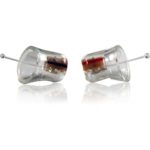Disclosure: Some of the links in this post are affiliate links. As an Amazon Associate, we earn from qualifying purchases. If you click on the link and purchase the item, we may receive an affiliate commission, at no extra cost to you. Learn more
Ear plug is a pretty simple and straightforward device, isn’t it? You take one out, then plug it into an ear and it’s done. Easy? Well, it’s not a rocket science but did you know that improperly used ear plugs can reduce the noise reduction effectiveness by over 50%?
So, if you want to enjoy a beautiful sound of silence when sleeping or while in a plane, it’s good to know how to insert and remove ear plugs to experience the advertised noise reduction ratio for each type of the earplugs. Here’s what you need to know.
How to Use Foam Ear Plugs
Wash hands thoroughly before handling ear plugs to avoid introducing bacteria into the ear canal. Just prior to insertion, foam plugs should be rolled between thumb and fingers into a tightly compressed, long, narrow cylinder, being careful not to crease the foam.
For the right ear, hold the tightly rolled ear plug in the right hand, cross the left arm across the top or even the back of the head and grasp the top of the right ear and gently but firmly pull it upwards and away from the head. This will straighten and open the ear canal and is very important for inserting foam ear plugs deeply enough into the ear canal.
The ear plug should be slid into the canal in an upward and backward direction as this is the natural direction of the canal – it should go in very easily if the ear is pulled gently and the plug pushed in at the right angle. The ear plug must be held in place, allowing the foam to slowly expand to fill the ear canal tightly and completely.
Once successfully inserted, a foam ear plug should be mostly inside the ear canal with only a small amount visible. If too much of the plug can be seen then it has not been inserted correctly and should be removed, rolled more tightly and reinserted. Repeat the whole process for the left, rolling the ear plug and inserting it with the left hand while pulling the ear up and away from the head with the right hand.
Always insert ear plugs one at a time and take the necessary time to insert them properly – this is the only way to ensure they are properly inserted and giving full protection from loud noise and the possibility of hearing loss.
Foam ear plugs should be removed carefully and slowly, with a turn of the plug, to avoid damage to the ear drum. Ear wax should be removed and the foam ear plugs washed in warm soapy water if necessary. Most foam plugs are only designed to be worn once or twice and so should be disposed of and replaced frequently to ensure effective, safe and continued protection.
>> Jump to: bulk ear plugs
Using Wax and Silicone Ear Plugs
Take the wax or silicone ear plugs one at a time and roll the ball into a tapering cylinder or fat cone. For the right ear, hold the molded ear plug in the right hand, cross the left arm across the top or even the back of the head and grasp the top of the right ear and gently but firmly pull it upwards and away from the head. This will straighten and open the ear canal and allow the ear plugs to enter into the ear canal.
The ear plug should be pushed into the canal in an upward and backward direction as this is the natural shape of the ear. Once in place, soft wax or silicon ear plugs should then be squashed firmly into the entrance of the ear so that a flat disc forms on the outside of the ear. Pressed firmly in, this will help keep water from entering the ear canal if a water-proof seal is required.
Repeat the whole process for the left, molding the ear plug and inserting it with the left hand while pulling the ear up and away from the head with the right hand. Always insert ear plugs one at a time and take enough time to insert them properly. This is the only way to ensure they are properly inserted and that they deliver full protection from noise and ensuing hearing loss.
Remove wax or silicon ear plugs slowly and gently to allow the pressure inside and outside the ear to equalize gradually. Moldable ear plugs can be washed with soap and water but should be replaced frequently to avoid ear irritation and infections.
>> See all best selling ear plugs on Amazon <<
How to Use Flanged Earplugs
Flanged ear plugs do not require any rolling or shaping before insertion and can be handled by the stem, but freshly washed hands are still a good idea to avoid any ear infection ensuing from bacteria on the fingers.
The ear plugs should then be inserted one by one in a similar way to others, using one hand to reach across and over the head to pull the ear gently upwards and away from the head to open the ear canal. With the other hand, push the ear plug into the canal in an upward and backward direction, following the natural direction of the shape of the ear. The seal of the flanges should be felt inside the ear – if not, the plug should be gently removed and reinserted.
Flanged ear plugs should be removed by gently pulling and twisting the stem, slowly allowing the seal the break without damaging or hurting the ear and ear drum. The ear plugs must be thoroughly washed with soapy water, rinsed and dried before reuse.
Read our in-depth guide to see what the best ear plugs are, or go here to see available earplugs on Amazon.
Disclosure: Some of the links in this post are affiliate links. As an Amazon Associate, we earn from qualifying purchases. If you click on the link and purchase the item, we may receive an affiliate commission, at no extra cost to you. Learn more





































Add Comment